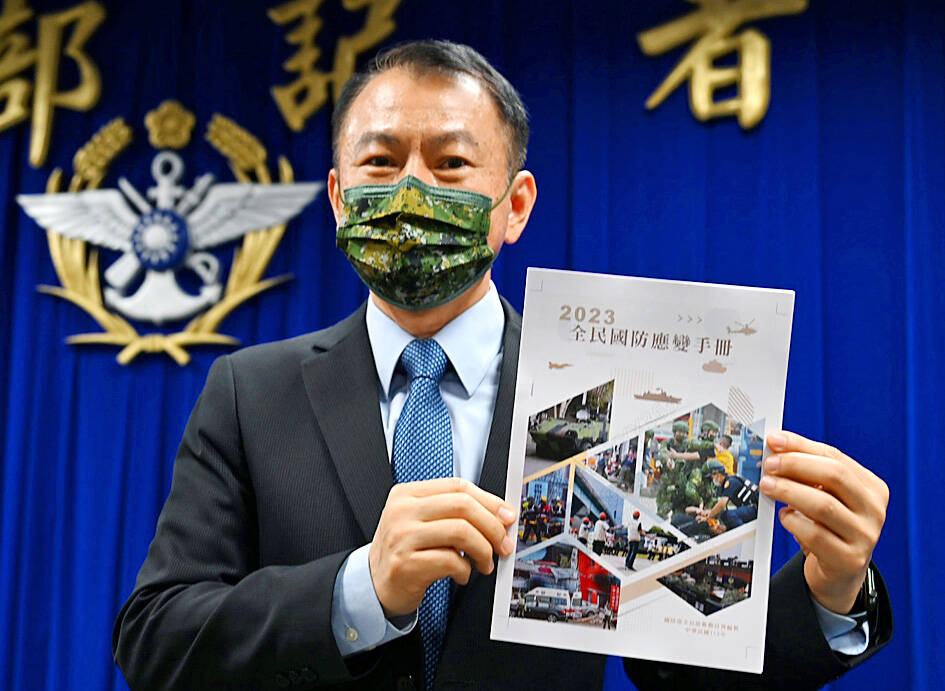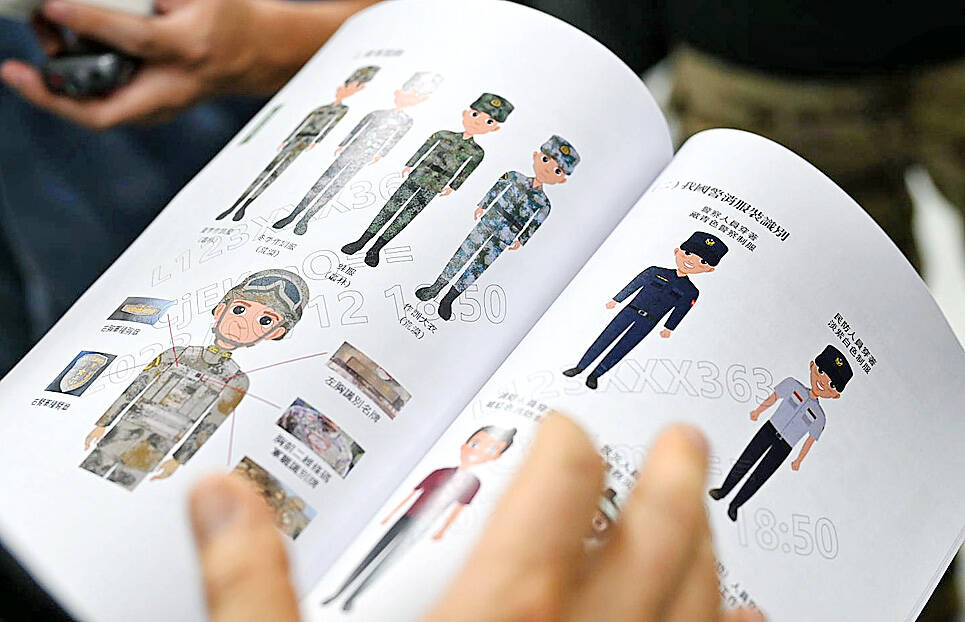A system to discern friend from foe, and instant access to accurate information are among the highlights of the latest version of the All-Out Defense Response Handbook, which the Ministry of National Defense released yesterday.
The ministry presented the handbook at a news conference in Taipei after it spent more than a year revising a version it published in April last year.
The handbook has been expanded from 28 to 48 pages, the ministry said.

Photo: Chang Chia-ming, Taipei Times
All-Out Defense Mobilization Agency Director Shen Wei-chih (沈威志) said that the handbook has two main sections: “Peacetime Preparedness” and “Wartime Response.”
“Peacetime Preparedness” covers items that should be prepared for an emergency evacuation, distinguishing air-raid alerts, knowledge of important facilities and accessing accurate information.
“Wartime Response” covers possible combat situations, including telling friend from foe; conducting an emergency evacuation; handling of water, power or food shortages and other disruptions of daily necessities; addressing communications disruptions; responding to medical emergencies; managing battlefield crises caused by fire, explosives, chemical weapons or missiles; and contacting emergency hotlines.

Photo: Chang Chia-ming, Taipei Times
The handbook shows uniforms and insignia worn by service personnel in Taiwan’s army, navy, air force and Marine Corps, as well as those worn by members of the Chinese People’s Liberation Army (PLA).
“After Russia invaded Ukraine, many have suggested that the handbook should prepare the public for severe wartime situations and offer them adequate information to respond to changes,” Shen said. “As such, we consulted similar books published in other countries, and suggestions proposed by lawmakers and experts to compile the handbook.”
The handbook has information about air-raid shelters, hospitals with emergency rooms and rationing of daily necessities, and allows people to check locations on an app, Shen said.
During wartime, it is important that people do not believe rumors about defeat or surrender by the government, he said.
Nearly 94 percent of the nation’s air defense shelters have been inspected since Aug. 8 last year, the National Police Agency’s Civil Defense and Command Control Center deputy director Lin Kuo-hua (林國華) told the news conference.
Inspections of the remaining shelters should be completed during the first half of next month, Lin said.
Of the 89,405 air defense shelters across Taiwan, 83,691 have been inspected, he said.
“We are in the process of upgrading signs for air defense shelters across the country,” he said.
“Some local governments have been asked to laminate signs to prevent water damage,” he said. “Two regions have printed signs on acrylic panels. Should funding allow, cities and counties are encouraged to use LED panels for the signs.”
As of Wednesday last week, 83.4 percent of the signs had been upgraded, he added.

The US government has signed defense cooperation agreements with Japan and the Philippines to boost the deterrence capabilities of countries in the first island chain, a report by the National Security Bureau (NSB) showed. The main countries on the first island chain include the two nations and Taiwan. The bureau is to present the report at a meeting of the legislature’s Foreign Affairs and National Defense Committee tomorrow. The US military has deployed Typhon missile systems to Japan’s Yamaguchi Prefecture and Zambales province in the Philippines during their joint military exercises. It has also installed NMESIS anti-ship systems in Japan’s Okinawa

‘WIN-WIN’: The Philippines, and central and eastern European countries are important potential drone cooperation partners, Minister of Foreign Affairs Lin Chia-lung said Minister of Foreign Affairs Lin Chia-lung (林佳龍) in an interview published yesterday confirmed that there are joint ventures between Taiwan and Poland in the drone industry. Lin made the remark in an exclusive interview with the Chinese-language Liberty Times (the Taipei Times’ sister paper). The government-backed Taiwan Excellence Drone International Business Opportunities Alliance and the Polish Chamber of Unmanned Systems on Wednesday last week signed a memorandum of understanding in Poland to develop a “non-China” supply chain for drones and work together on key technologies. Asked if Taiwan prioritized Poland among central and eastern European countries in drone collaboration, Lin

NO CONFIDENCE MOTION? The premier said that being toppled by the legislature for defending the Constitution would be a democratic badge of honor for him Premier Cho Jung-tai (卓榮泰) yesterday announced that the Cabinet would not countersign the amendments to the local revenue-sharing law passed by the Legislative Yuan last month. Cho said the decision not to countersign the amendments to the Act Governing the Allocation of Government Revenues and Expenditures (財政收支劃分法) was made in accordance with the Constitution. “The decision aims to safeguard our Constitution,” he said. The Constitution stipulates the president shall, in accordance with law, promulgate laws and issue mandates with the countersignature of the head of the Executive Yuan, or with the countersignatures of both the head of the Executive Yuan and ministers or

CABINET APPROVAL: People seeking assisted reproduction must be assessed to determine whether they would be adequate parents, the planned changes say Proposed amendments to the Assisted Reproduction Act (人工生殖法) advanced yesterday by the Executive Yuan would grant married lesbian couples and single women access to legal assisted reproductive services. The proposed revisions are “based on the fundamental principle of respecting women’s reproductive autonomy,” Cabinet spokesperson Michelle Lee (李慧芝) quoted Vice Premier Cheng Li-chiun (鄭麗君), who presided over a Cabinet meeting earlier yesterday, as saying at the briefing. The draft amendment would be submitted to the legislature for review. The Ministry of Health and Welfare, which proposed the amendments, said that experts on children’s rights, gender equality, law and medicine attended cross-disciplinary meetings, adding that